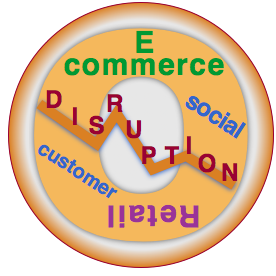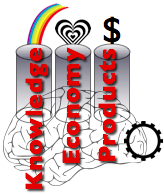Empowered customers and omni-channel commerce are mirrors of each other, and both are transforming “retail.”
 [UPDATED] Connected customers have the Internet in their pockets and use mobile and other devices in all stages of conceptualizing, considering, evaluating, buying and using purchased products and services. These customers want to interact with firms and brands in a seamless experience that features single sign-on as an entry point; they want the firm to respond using their individual data when that makes interacting more valuable. Omni-channel commerce refers to a collection of technologies, practices and strategies firms use to provide the personal individualized experience that connected customers expect. [UPDATED] Connected customers have the Internet in their pockets and use mobile and other devices in all stages of conceptualizing, considering, evaluating, buying and using purchased products and services. These customers want to interact with firms and brands in a seamless experience that features single sign-on as an entry point; they want the firm to respond using their individual data when that makes interacting more valuable. Omni-channel commerce refers to a collection of technologies, practices and strategies firms use to provide the personal individualized experience that connected customers expect.
IBM’s 2012 study of retail customers in eight mature economies (Australia, Canada, France, Italy, Japan, Spain, the UK and the USA) and seven growth economies (Argentina, Brazil, Chile, China, Colombia, Mexico and South Africa) lays bare that the retail “shopping” experience has shifted profoundly, although you wouldn’t know it by looking at most offline or online retailers’ presences. The paper, “Winning over the empowered consumer: Why trust matters,” is a call to […]
![Social Media Upgrade [Social Business Team Building] case1](http://rollyson.net/wp-content/uploads/2013/04/sbtb1.png) [Updated] The Social Media Upgrade applies to most consumer-oriented brands that have been outsourcing much of their social media work to agencies. In 2013, digital marketing and brand executives are thinking about building their internal teams to provide more continuity and scale. [Updated] The Social Media Upgrade applies to most consumer-oriented brands that have been outsourcing much of their social media work to agencies. In 2013, digital marketing and brand executives are thinking about building their internal teams to provide more continuity and scale.
Social Media Upgrade is the first of the five-part social business team building series The series describes team building in the context of various scenarios in which firms build social business capability, step by step, while investing wisely. Social Business Strategy Use Cases outlines and compares all five use cases while Social Business Team Building gives general guidance for how to create social business teams as well as recommendations for what characteristics leaders have, so I recommend reading them, too.
[…]
 [UPDATED] Several profound market forces are preparing the ascendancy of Knowledge Economy products, which result from collaboration among designers, artists, engineers, customers and firms. This represents one of the Knowledge Economy’s most exciting-yet-disruptive elements: “products” will cease to be dominated by monolithic factories that mass produce virtually all items that people use and consume. Moreover, people have an inherent joy when they can make things for themselves, their friends and their families—and a dramatic new wave of creativity and innovation is imminent. To help you wrap your mind around Knowledge Economy products, this post will recall what happened to mass media and entertainment industries. [UPDATED] Several profound market forces are preparing the ascendancy of Knowledge Economy products, which result from collaboration among designers, artists, engineers, customers and firms. This represents one of the Knowledge Economy’s most exciting-yet-disruptive elements: “products” will cease to be dominated by monolithic factories that mass produce virtually all items that people use and consume. Moreover, people have an inherent joy when they can make things for themselves, their friends and their families—and a dramatic new wave of creativity and innovation is imminent. To help you wrap your mind around Knowledge Economy products, this post will recall what happened to mass media and entertainment industries.
Knowledge Economy products are conceived, designed, prototyped and fabricated in the Social Channel. Best practices in open source, Agile development, design and Web development will unleash continuous innovation at a scale and pace we’ve never seen before. Knowledge and innovation will be free in the Knowledge Economy because all supporting processes will become an order of magnitude faster and cheaper. Firms and brands that do not recognize and respond quickly enough will become irrelevant.
Most brands […]
 The fascinating post in the Read Write Web outlines a new trend, “Relocalization” or the inevitable “Local 2.0” that’s a backlash against malls, industrial “retail” and online “community.” It predicts a resurgence of “face to face” interaction, and people paying a premium for locally produced products and “townish” community. The fascinating post in the Read Write Web outlines a new trend, “Relocalization” or the inevitable “Local 2.0” that’s a backlash against malls, industrial “retail” and online “community.” It predicts a resurgence of “face to face” interaction, and people paying a premium for locally produced products and “townish” community.
It’s a new synthesis: people increasingly don’t believe in commuting, and many workers are accustomed to working “from home” or in Starbucks or other public coworking spaces. Local 2.0 carries a strong green, anti-carbon tinge as well. And it’s not at all incompatible with periodic jetsetting, everything can interoperate. Definitely worth watching!
 In case you missed it, this seminal post from the New York Times shows a startling example of “big data” hitting retail. Data collection and mining have enabled Target, for example, to predict what degree of pregancy young mothers are in—based on the kind of things they buy. In case you missed it, this seminal post from the New York Times shows a startling example of “big data” hitting retail. Data collection and mining have enabled Target, for example, to predict what degree of pregancy young mothers are in—based on the kind of things they buy.
Although Valley visionaries and enterprise data engineers have been talking about “big data” for years, this post brings it down to the personal retail level. Due to the growing appreciation of social data and behavior, data scientists and marketers now have the glue to use data to increase relevance to customers and clients.
In this post’s main example, data engineers analyzed purchase behavior of pregnant mothers, sifting through voluminous retail data, and they found plenty of patterns that indicated that women were pregnant, down to the trimester! Obviously, enterprises have a large responsibility to use data in ways that won’t violate trust, and many will make mistakes in their efforts to pump up quarterly numbers.Put another way, buying transactions are *very* social, so retailers, whether bricks and mortar or ecommerce, will unleash tremendous intelligence in […]
 Giving as Smart Business: Blake Mycoskie, Founder TOMS Shoes is a fantastic story and a smart business idea. Blake Mycoskie is a gifted storyteller in his own right, and, in this South by Southwest 2011 keynote, he entertained the audience with the story of TOMS Shoes while imparting a simple but profound principle of 21st century business: discovering the meaning and potential of giving. Here are the highlights of TOMS story, which will help you appreciate the context of the blockbuster business idea. Giving as Smart Business: Blake Mycoskie, Founder TOMS Shoes is a fantastic story and a smart business idea. Blake Mycoskie is a gifted storyteller in his own right, and, in this South by Southwest 2011 keynote, he entertained the audience with the story of TOMS Shoes while imparting a simple but profound principle of 21st century business: discovering the meaning and potential of giving. Here are the highlights of TOMS story, which will help you appreciate the context of the blockbuster business idea.
[…]
 Social Business Case Study: Jennifer DeMarco Herskind, Dave & Buster’s summarized how Dave & Buster’s was beginning to see results from their social media initiatives. She presented it at Alterian’s Social Business Engaging Times Summit. Social Business Case Study: Jennifer DeMarco Herskind, Dave & Buster’s summarized how Dave & Buster’s was beginning to see results from their social media initiatives. She presented it at Alterian’s Social Business Engaging Times Summit.
In the U.S., they have 57 stores, and each averages 40,000 sq.ft. of gaming and restaurants. July 2010 marked their first anniversary of doing social media. Customers are totally online, especially the 18-24 and 25-34 age groups, talking about food and entertainment; Dave & Buster’s benchmark themselves against casual dining because it has similar demographics. They go to where the customers are. There’s a fundamental shift (in marketing), and we have to get social media into the decision set. Facebook is the most important right now. We have a new data warehouse and customer surveys. […]
The WSJ succeeded in charging for content because their content was traditionally part of their customers’ workstreams. When your livelihood depends on something, you pay. Most “news” and media entertains, it has little financial impact. […]
Social networking insights from the Miami Dolphins’ Jim Rushton, SVP Corporate Partnerships and Integrated Media […]
How the Seattle Seahawks and the Seattle Sounders are using social networking and social media to engage fans online and offline […]
|
|
 [UPDATED] Connected customers have the Internet in their pockets and use mobile and other devices in all stages of conceptualizing, considering, evaluating, buying and using purchased products and services. These customers want to interact with firms and brands in a seamless experience that features single sign-on as an entry point; they want the firm to respond using their individual data when that makes interacting more valuable. Omni-channel commerce refers to a collection of technologies, practices and strategies firms use to provide the personal individualized experience that connected customers expect.
[UPDATED] Connected customers have the Internet in their pockets and use mobile and other devices in all stages of conceptualizing, considering, evaluating, buying and using purchased products and services. These customers want to interact with firms and brands in a seamless experience that features single sign-on as an entry point; they want the firm to respond using their individual data when that makes interacting more valuable. Omni-channel commerce refers to a collection of technologies, practices and strategies firms use to provide the personal individualized experience that connected customers expect.
![Social Media Upgrade [Social Business Team Building] case1](http://rollyson.net/wp-content/uploads/2013/04/sbtb1.png) [Updated] The Social Media Upgrade applies to most consumer-oriented brands that have been outsourcing much of their social media work to agencies. In 2013, digital marketing and brand executives are thinking about building their internal teams to provide more continuity and scale.
[Updated] The Social Media Upgrade applies to most consumer-oriented brands that have been outsourcing much of their social media work to agencies. In 2013, digital marketing and brand executives are thinking about building their internal teams to provide more continuity and scale. [UPDATED] Several profound market forces are preparing the ascendancy of Knowledge Economy products, which result from collaboration among designers, artists, engineers, customers and firms. This represents one of the Knowledge Economy’s most exciting-yet-disruptive elements: “products” will cease to be dominated by monolithic factories that mass produce virtually all items that people use and consume. Moreover, people have an inherent joy when they can make things for themselves, their friends and their families—and a dramatic new wave of creativity and innovation is imminent. To help you wrap your mind around Knowledge Economy products, this post will recall what happened to mass media and entertainment industries.
[UPDATED] Several profound market forces are preparing the ascendancy of Knowledge Economy products, which result from collaboration among designers, artists, engineers, customers and firms. This represents one of the Knowledge Economy’s most exciting-yet-disruptive elements: “products” will cease to be dominated by monolithic factories that mass produce virtually all items that people use and consume. Moreover, people have an inherent joy when they can make things for themselves, their friends and their families—and a dramatic new wave of creativity and innovation is imminent. To help you wrap your mind around Knowledge Economy products, this post will recall what happened to mass media and entertainment industries. The fascinating post in the Read Write Web outlines a new trend, “Relocalization” or the inevitable “Local 2.0” that’s a backlash against malls, industrial “retail” and online “community.” It predicts a resurgence of “face to face” interaction, and people paying a premium for locally produced products and “townish” community.
The fascinating post in the Read Write Web outlines a new trend, “Relocalization” or the inevitable “Local 2.0” that’s a backlash against malls, industrial “retail” and online “community.” It predicts a resurgence of “face to face” interaction, and people paying a premium for locally produced products and “townish” community. Giving as Smart Business: Blake Mycoskie, Founder TOMS Shoes is a fantastic story and a smart business idea. Blake Mycoskie is a gifted storyteller in his own right, and, in this South by Southwest 2011 keynote, he entertained the audience with the story of TOMS Shoes while imparting a simple but profound principle of 21st century business: discovering the meaning and potential of giving. Here are the highlights of TOMS story, which will help you appreciate the context of the blockbuster business idea.
Giving as Smart Business: Blake Mycoskie, Founder TOMS Shoes is a fantastic story and a smart business idea. Blake Mycoskie is a gifted storyteller in his own right, and, in this South by Southwest 2011 keynote, he entertained the audience with the story of TOMS Shoes while imparting a simple but profound principle of 21st century business: discovering the meaning and potential of giving. Here are the highlights of TOMS story, which will help you appreciate the context of the blockbuster business idea. Social Business Case Study: Jennifer DeMarco Herskind, Dave & Buster’s summarized how Dave & Buster’s was beginning to see results from their social media initiatives. She presented it at Alterian’s Social Business Engaging Times Summit.
Social Business Case Study: Jennifer DeMarco Herskind, Dave & Buster’s summarized how Dave & Buster’s was beginning to see results from their social media initiatives. She presented it at Alterian’s Social Business Engaging Times Summit.